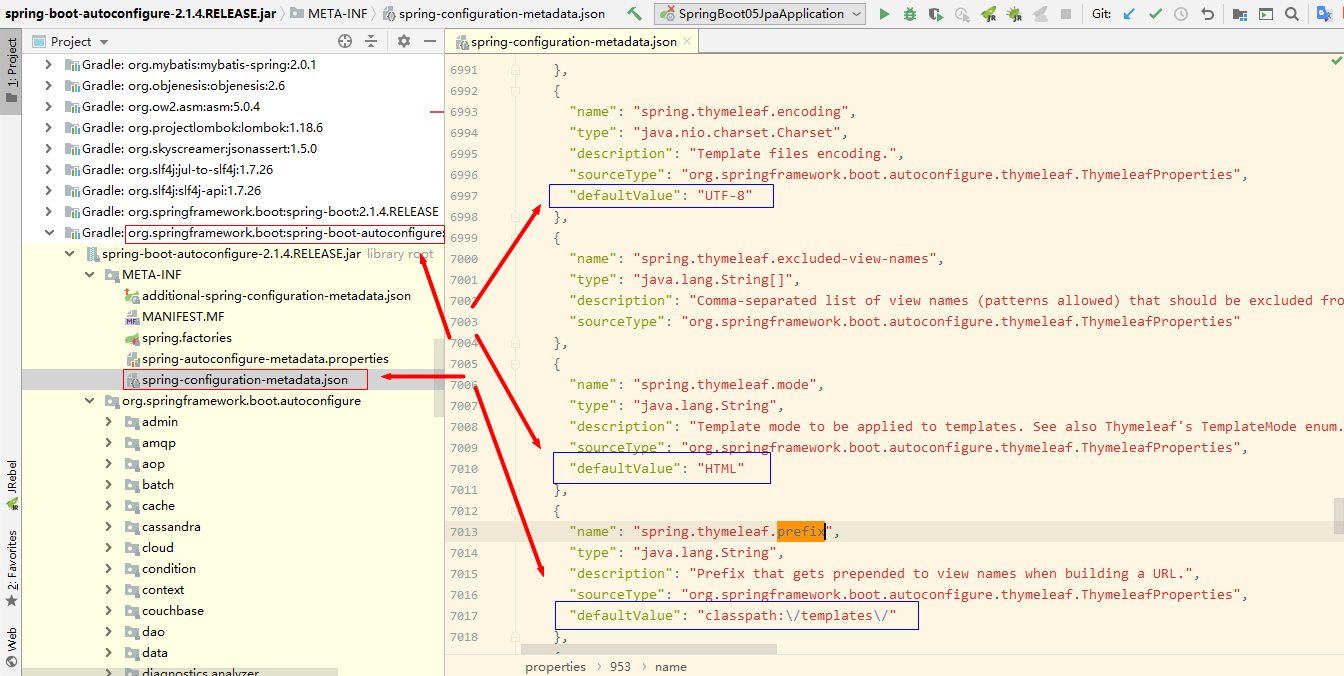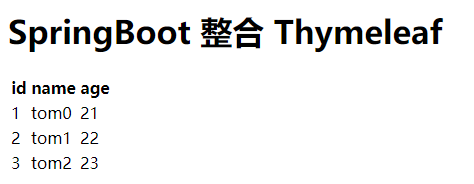1.创建子模块
这里我们创建一个子模块
1
2
| group = 'com.ray.study'
artifact ='spring-boot-03-thymeleaf'
|
2.引入依赖
2.1 继承父工程依赖
在父工程spring-boot-seeds 的 settings.gradle加入子工程
1
2
3
4
| rootProject.name = 'spring-boot-seeds'
include 'spring-boot-01-helloworld'
include 'spring-boot-02-restful-test'
include 'spring-boot-03-thymeleaf'
|
这样,子工程spring-boot-03-thymeleaf就会自动继承父工程中subprojects `函数里声明的依赖,主要包含如下依赖:
1
2
3
4
5
| implementation 'org.springframework.boot:spring-boot-starter-web'
testImplementation 'org.springframework.boot:spring-boot-starter-test'
compileOnly 'org.projectlombok:lombok'
annotationProcessor 'org.projectlombok:lombok'
|
2.2 引入thymeleaf依赖
直接依赖 spring-boot-starter-thymeleaf即可
将子模块spring-boot-03-thymeleaf 的build.gradle修改为如下内容:
1
2
3
4
| dependencies {
implementation 'org.springframework.boot:spring-boot-starter-thymeleaf'
}
|
3.修改配置
3.1 thymeleaf默认配置
ThymeleafProperties类中设置了 thymeleaf默认配置,如下所示:
1
2
3
4
5
6
7
8
9
10
11
12
13
14
15
16
17
18
19
20
21
22
23
24
25
26
27
28
29
30
31
32
33
34
35
36
37
38
39
40
41
42
43
44
| @ConfigurationProperties(prefix = "spring.thymeleaf")
public class ThymeleafProperties {
private static final Charset DEFAULT_ENCODING = StandardCharsets.UTF_8;
public static final String DEFAULT_PREFIX = "classpath:/templates/";
public static final String DEFAULT_SUFFIX = ".html";
private boolean checkTemplate = true;
private boolean checkTemplateLocation = true;
private String prefix = DEFAULT_PREFIX;
private String suffix = DEFAULT_SUFFIX;
private String mode = "HTML";
private Charset encoding = DEFAULT_ENCODING;
private boolean cache = true;
|
由ThymeleafProperties类可看出,默认配置了
- 模板文件编码:
UTF-8
- 模板文件前缀:
classpath:/templates/
- 模板文件后缀:
.html,由前缀和后缀可得出模板文件路径为:src/main/resources/templates/{viewName}.html
- 开启了模板缓存:由于开发时,需要经常修改模板,模板缓存会使我们的修改无法及时生效,因此开发时需要禁用模板缓存
- 设置了模板模式为
HTML:我们会将此修改为HTML5
关于默认配置也可在spring-boot-autoconfigure工程下的的spring-configuration-metadata.json文件中查看,如下图:

3.2 修改application.yml
1
2
3
4
5
6
7
8
9
10
11
12
13
| server:
port: 8088
servlet:
context-path: /
spring:
thymeleaf:
mode: HTML5
cache: false
|
4.业务实现
所谓模板引擎,就是模板+数据
这里我们将实现一个显示用户列表的功能
4.1 准备数据
4.1.1 model
1
2
3
4
5
6
7
8
9
10
11
12
13
14
15
16
17
18
19
20
21
22
23
24
| package com.ray.study.springboot03thymeleaf.model;
import lombok.AllArgsConstructor;
import lombok.Data;
import lombok.NoArgsConstructor;
@Data
@NoArgsConstructor
@AllArgsConstructor
public class User {
private Long id;
private String name;
private Integer age;
}
|
4.1.2 controller
1
2
3
4
5
6
7
8
9
10
11
12
13
14
15
16
17
18
19
20
21
22
23
24
25
26
27
28
29
30
31
32
33
34
35
36
37
38
39
40
41
42
43
44
45
46
47
48
49
50
51
52
53
54
55
56
57
58
59
60
61
62
63
| package com.ray.study.springboot03thymeleaf.controller;
import com.ray.study.springboot03thymeleaf.model.User;
import org.springframework.stereotype.Controller;
import org.springframework.ui.Model;
import org.springframework.web.bind.annotation.GetMapping;
import org.springframework.web.bind.annotation.RequestMapping;
import org.springframework.web.servlet.ModelAndView;
import java.util.ArrayList;
import java.util.List;
@Controller
@RequestMapping(value = "/users")
public class UserController {
@GetMapping("/index1")
public ModelAndView index1() {
List<User> userList = listUser();
ModelAndView view = new ModelAndView();
view.setViewName("index");
view.addObject("title", "SpringBoot 整合 Thymeleaf");
view.addObject("userList", userList);
return view;
}
@GetMapping("/index2")
public String index2(Model model) {
List<User> userList = listUser();
model.addAttribute("title", "SpringBoot 整合 Thymeleaf");
model.addAttribute("userList", userList);
return "index";
}
private List<User> listUser(){
List<User> userList = new ArrayList<>();
for (int i=0 ; i<3; i++){
userList.add(new User(1L+i,"tom"+i,21+i));
}
return userList;
}
}
|
4.2 准备模板
在src/main/resources下创建templates目录,并在此目录下创建index.html,内容如下:
1
2
3
4
5
6
7
8
9
10
11
12
13
14
15
16
17
18
19
20
21
22
23
24
25
26
27
28
| <!DOCTYPE html>
<html lang="en" xmlns:th="http://www.thymeleaf.org">
<head>
<meta charset="UTF-8">
<title th:text="${title}"></title>
</head>
<body>
<h1 th:text="${title}"></h1>
<table>
<tr>
<th>id</th>
<th>name</th>
<th>age</th>
</tr>
<tr th:each="user : ${userList}">
<td th:text="${user.id}">id</td>
<td th:text="${user.name}">userName</td>
<td th:text="${user.age}">age</td>
</tr>
</table>
</body>
</html>
|
5.最终效果
启动项目,然后访问如下两个网址
会出现下图页面:


